Like most visitors to Charleston, South Carolina, a trip to Fort Sumter was high on my list of tourist destinations. There is one concessionaire for getting a boat to the island in Charleston Harbor where the Fort Sumter National Monument is located. There are only three departure times daily March 15 to August 20 at 9:30am, noon and 2:30pm from Liberty Square, the location of the South Carolina Aquarium in Charleston. Fort Sumter is a popular place for tourists and there were loads of tourists in Charleston during my visit.
Sullivan’s Island fields at Fort Moultrie.
Besides Charleston, there are also three daily boat departures from Mount Pleasant, the town across the U.S. Route 17 Arthur Ravenel Jr. Bridge over Cooper River. These times are later at 10:45am, 1:30pm and 4:00pm departing from Patriots Point, Mount Pleasant. The dock is near the Naval and Maritime Museum Museum, home of the USS Yorktown. The museum is open 9:00am -6:30 pm daily. One advantage of Patriots Point is $5 all day parking. Charleston costs more to park.
Arthur Ravenel Jr. Bridge, seen from Sullivan’s Island, South Carolina, connects Charleston with Mount Pleasant across the Cooper River. The bridge allows pedestrian and cycling traffic on a dedicated paved public access path. The bridge is #2 of the top things to do attractions in the city of Charleston according to TripAdvisor.com.
Beneath the Mount Pleasant side of the bridge is a visitor center at the same parking area under the bridge where there is the pedestrian and cycling path access to the bridge. The thought of walking the bridge seemed like a good idea, except 95 degrees and possibly more heat and noise from vehicle traffic changed my desire.
The woman staffing the visitor center recommended I visit Fort Moultrie while I was in the area. Fort Moultrie is part of Fort Sumter National Monument and the initial military fort protecting the entrance to Charleston Harbor since the Revolutionary War.
Fort Moultrie, part of Fort Sumter National Monument
Sullivan’s Island is perhaps the most significant historical site in the social history of America that you may never have heard of until reading this. Sullivan’s Island is a place near Charleston that I happened upon by chance as I drove across the Arthur Ravenel Jr. Bridge to reach the parking lot for a bridge walk before heading out on a cruise to Fort Sumter National Monument.
Arthur Ravenel Jr. Bridge and Fort Sumter tours are two of the major tourist activities when visiting Charleston. Sullivan’s Island is another destination about seven miles from Charleston that can be added to a day tour of the bridge walk, Fort Sumter tour and the USS York aircraft carrier museum at Patriots Point.
Arthur Ravenel Jr. Bridge
Arthur Ravenel Jr. Bridge is listed as TripAdvisor #2 of 105 attractions in Charleston, South Carolina. Yeah, it really is a bridge over the Cooper River separating Charleston from Mt. Pleasant. The river is wide at the Charleston Peninsula. The attraction is a dedicated cycling/walking path on the major commuter highway across Charleston Harbor.
Mount Pleasant Visitor Center is located on the eastern bank of Charleston Harbor beside the Arthur Ravenel Jr. Bridge. Mount Pleasant Visitors Center bridge view. There is a parking lot here for pedestrian and cycling bridge access.
On my second day in Charleston I attempted to catch the free shuttle that runs from the outer parts of the Charleston Peninsula like where Marriott Charleston is located. Parking and driving is a real hassle in the small historic downtown area of Charleston during daytime hours.
The air was 95F hot in clear skies. I had already been outside close to one hour after missing the earlier trolley. The every-30-minutes free trolley into downtown was 30 minutes late. That illustrates the kind of downtown Charleston traffic that throws any kind of time prediction way off the clock.
Walking two miles is generally not a problem, if it were not so hot.
I jumped in my car for a photographic hike opportunity on the Arthur Ravenel Jr. Bridge. The idea did not seem as good to me when I stepped outside my car at noon and the 95F air hits me in the face as I stood below the six lane highway listening to the loud rumbling and clanking of hundreds of cars and trucks passing overhead.
In my travels all plans are soft until the moment the decision is irreversible without penalty. The Mount Pleasant Visitors Center is in a large park setting beneath the Arthur Ravenel Jr. Bridge with a pier for fishing extending 1,250 feet out over the Cooper River. The woman staffing the center told me the cost to park my car at the Mount Pleasant ferry port for Fort Sumter Tours is only $5 compared to $10 and $15 around Charleston. She also mentioned another place, Fort Moultrie on Sullivan’s Island as a good place to visit.
Fort Sumter National Monument
Fort Sumter National Monument is managed by the federal National Park Service and one company, Fort Sumter Tours, has the exclusive transportation concession to operate the ferry from either Charleston or Patriot Point at Mount Pleasant to the pier at Fort Sumter in Charleston Harbor. The harbor tour is 2 hours 15 minutes with one hour at the island of Fort Sumter. Adults $18, Seniors (62+) $16, Children (4-11) $11.
The cruise schedule is peak season March 15 – August 20 with 3 daily Fort Sumter cruises from Charleston (9:30am, noon, 2:30pm) and three from Mount Pleasant (10:45am, 1:30pm, 4:00pm).
Something about the lady’s description of the scenic beauty and quietness of Sullivan’s Island sent me and my car in that direction.
Charleston Harbor Map with Mount Pleasant upper right and Sullivan’s Island borders the northern approach to Charleston Harbor. Morris Island is the southern approach to Charleston Harbor and the place where Fort Wagner fortifications existed in the Civil War. Fort Wagner is the Union attack by the 54th Massachusetts Volunteer Infantry, an all black military unit led by the white Colonel Robert Gould Shaw. The military unit and battle are depicted in the popular 1989 film Glory with Matthew Broderick and Denzel Washington. Charleston peninsula is upper center with Cooper River bordering the north side of the peninsula and the Ashley River on the south side. James Island left and Fort Sumter a speck almost dead center at the mouth of Charleston Harbor.
Sullivan’s Island
Fort Sullivan was being constructed of palmetto logs and sand on the beachfront of Sullivan’s Island as a defensive fort for Charleston Harbor when nine British warships attacked on June 28, 1776. The palmetto log fort held off the cannon fire of the ships. The British retreated and the fort was renamed Fort Moultrie after the American commanding officer, Charleston’s Colonel William Moultrie (1730-1805). The strength of the palmetto logs is the inspiration behind palmetto trees in the flag of South Carolina. Charleston was eventually captured by British forces in 1780 and troops held the city until the end of the Revolutionary War in 1783.
Grave of Major General William Moultrie (1730-1805).
Fort Moultrie is a much older fort site than Fort Sumter which was commissioned after the War of 1812 to improve coastal fortifications. Fort Sumter was still incomplete when Union troops abandoned Fort Moultrie for the more defensible Fort Sumter after South Carolina seceded from the Union in December 1860. A siege by Confederate troops of Fort Sumter located on an island at the entrance to Charleston Harbor ended when Fort Sumter was bombarded by artillery fire on April 12, 1861 and Union forces surrendered April 14, 1861 in the initial military engagement of the Civil War.
Fort Moultrie Visitor Center on Sullivan’s Island.
Fort Sumter can be seen from Fort Moultrie. The strategic importance of the two locations was the ability to have a comprehensive line of fire against ships entering Charleston Harbor.
Fort Sumter on an island seen from Fort Moultrie.
Fort Moultrie is an historic site that covers 171 years of American warfare military history from the Revolutionary War to WWII. Another significant aspect of Fort Moultrie is the Sullivan’s Island location which was used in the 1700s as a quarantine station for African slaves entering Charleston. This was the primary entry point for around 260,000 slaves brought to the United States. It is estimated 80% of African-Americans today have an ancestor who passed through Sullivan’s Island.
African Passages Exhibit at Fort Moultrie Visitor Center.
Fort Moultrie has old cannons and bunkers to walk around where you can see the ammunition rooms and storehouses.
Civil War era cannon is mounted in a frame with wheels on a circular track to allow quick repositioning.
World War II era mounted guns at Fort Moultrie.
Fort Moultrie closed in 1947 as a military base and fell into disrepair until it was transferred to the National Park Service and became part of Fort Sumter National Monument in 1960. The fort underwent a major restoration project for the Bicentennial of the American Revolution and reopened to the public on June 28, 1976 with the Fort Moultrie Visitor Center across the street from the fort.
Fort Moultrie on Sullivan’s Island with historic Charleston barely visible some seven miles in the distance. There is an interesting story about the historical U.S. flag that flies over Fort Moultrie.
Vermont and Kentucky were admitted to the Union as the fourteen and fifteen states in the years 1791 and 1792. It was not until 1795 though, that they were properly added onto the national flag with both an additional star and stripe. For the next 23 years, a fifteen star/fifteen stripe flag, the one flying over Fort Moultrie today, served as the United States National Flag. By 1818, five additional states had been admitted into the Union. The unpopular idea of adding five more stripes caused Congress to pass legislation returning the number of stripes back to thirteen and, from then on, adding only an additional star for the newly admitted state.
In commemoration of the current Fort Moultrie being officially opened December 19, 1809, we fly the 15 star/15 stripe U.S. flag today.
Fort Moultrie – What flag is flying today?
Another historically significant marker at Fort Moultrie is the grave of American Indian warrior Osceola (1804-1838). In 1836, Osceola, a Creek Indian with a Scots-Irish father, led the Florida Seminole Indians in the Second Seminole War in resistance to forced tribal relocation from Florida. Osceola was captured by American troops when he met for peace negotiations near St. Augustine, Florida in September 1837. He was imprisoned and transferred to Fort Moultrie in December 1837 where he died January 30, 1838 from disease.
Grave of Indian leader Osceola outside Fort Moultrie wall.
With limited space for tours to Fort Sumter on the six daily boats to the island, Fort Moultrie is a cheaper alternative to visit Sullivan’s Island and walk the grounds for free. The Fort Moultrie Visitor Center exhibits and film are $4.
Fort Moultrie, Sullivan’s Island – part of Fort Sumter National Monument.
Related post: Sullivan’s Island, SC is perhaps the most significant historical site in the USA you never heard of (June 9, 2014) is my post on the historical significance of slavery and the African-American experience.
*****
Ric Garrido of Monterey, California is writer and owner of Loyalty Traveler.
Loyalty Traveler shares news and views on hotels, hotel loyalty programs and vacation destinations for frequent guests. Check out current hotel loyalty program offers across all the major chains in Loyalty Traveler’s monthly hotel promotions guide.
Follow Loyalty Traveler on Twitter and Facebook and RSS feed.


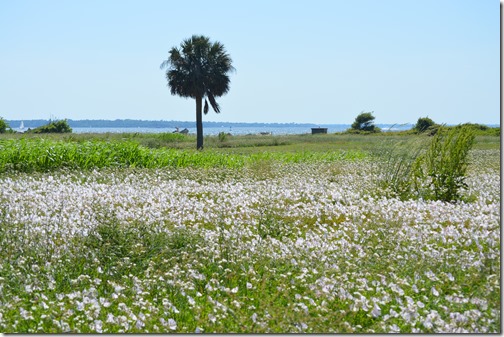

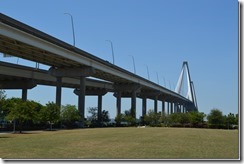

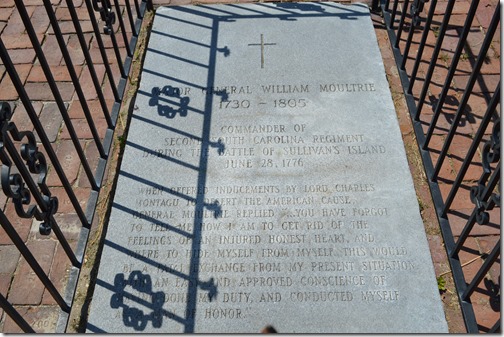
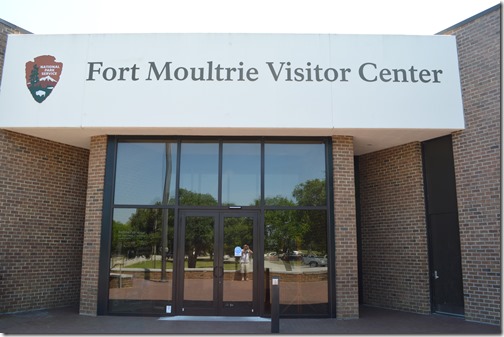
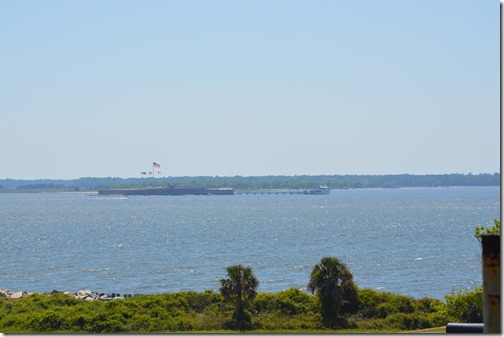
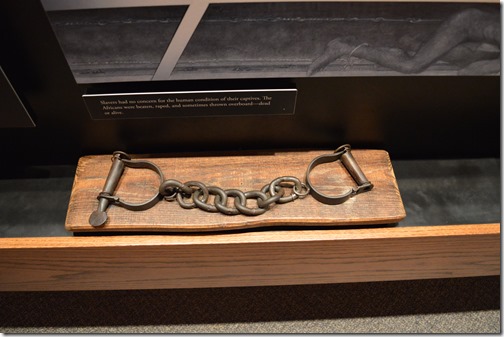
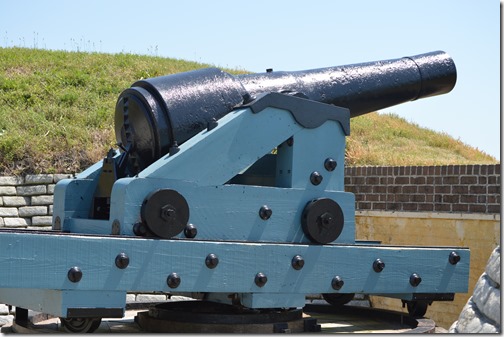
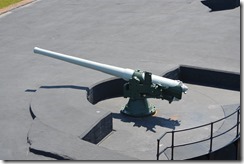

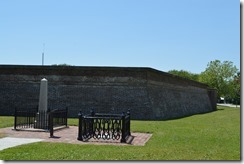
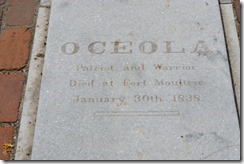
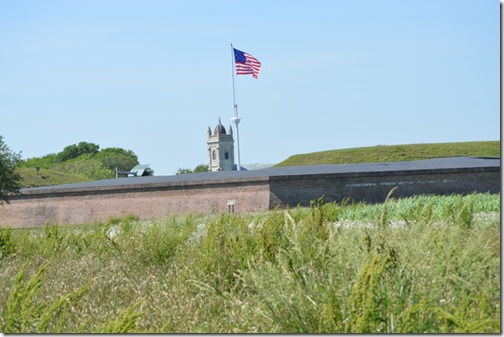

2 Comments
Comments are closed.